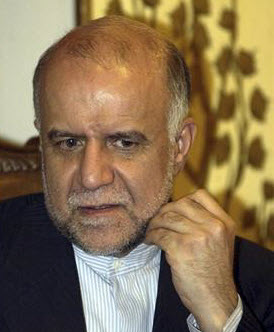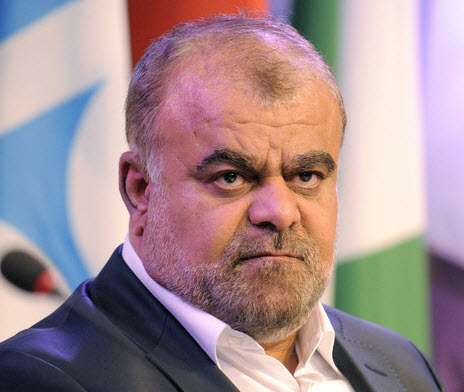
September 27-2013
Iran’s new oil minister, Bijan Namdar-Zanganeh, acknowledged publicly Sunday that Iran still imports gasoline and still makes some ersatz gasoline at petrochemical plants, despite claims otherwise by his predecessors.
But Zanganeh insisted oil imports would halt by next Now Ruz as new refineries come on stream. He did not say that the ersatz gasoline from petrochemical plants will halt by then, only that petrochemical gasoline “will decline” as new refineries open.
But it isn’t clear that gasoline imports will end by Now Ruz, as Zanganeh claimed. News reports last week said Iran plans to import about 15 percent of its gasoline from India.
Both the Fars and Mehr news agencies said the government plans to import premium Indian gasoline and mix it with lower quality Iranian gasoline in order to boost the octane level of the gasoline sold to Iranian drivers. The reports did not say what the octane level of Iranian regular gasoline is now or what it would be after the Indian gasoline is added.
The reports said Iran would import 8 to 10 million liters daily of Indian premium gasoline. Iranian gasoline consumption now runs about 65 million liters a day.
Mehr said Iran would “exchange” its crude for Indian premium gasoline, implying this is to be a barter deal. Presumably, India hopes that with a barter deal it will be able to avert US sanctions for selling gasoline to Iran. That, however, remains to be seen.
Zanganeh said imported gasoline would no longer be needed after Now Ruz because more cars are running on CNG (compressed natural gas) and because new refineries such as the giant Persian Gulf Star refinery will close the gap between gasoline consumption and supply by Now Ruz.
As recently as last January, then-Oil Minister Rostam Qasemi proclaimed that the Islamic Republic would become a gasoline exporter by Now Ruz six months ago. That announcement was just one of many frequent Iranian claims that the end of imported gasoline was near.

After Qasemi made his claim in January, a Majlis deputy said such talk was nonsense and Iran must continue importing gasoline for a long time. Deputy Mehdi Musavi-nejad said that eliminating gasoline imports was not feasible, because domestic production is far from meeting demand.
Oil officials have repeatedly announced the end of gasoline imports and the start of gasoline exports for the last three years.
In September 2010, then-Oil Minister Masud Mir-Kazemi announced that Iran had already achieved self-sufficiency in gasoline production. That was three years ago this month. The announcement came just after President Obama signed a new sanctions law that threatened to punish foreign firms that sold refined oil products to Iran. Such firms quickly lined up at the microphone to announce they were ending such sales.
US congressmen pushing the sanctions law had argued it would bring the Islamic Republic to its knees because the regime was dependent on gasoline imports. That made it crucial for the regime to show it could put enough gasoline on the market to prove the Americans wrong.
Later, Tehran announced that it was making gasoline at six petrochemical plants—Arak, Jam, Borzoyeh, Amir Kabir, Buali Sina and the aromatic unit at Imam Khomeini—that had been converted to gasoline production. In January 2011, officials said such production had ended since gasoline consumption dropped once prices were hiked as part of the end of fuel subsidies. But such production hadn’t ended. And Zanganeh admitted it still hasn’t ended.
Iranians commonly condemn the gasoline from petrochemical plants as being especially heavy in pollutants that have added to the unhealthy condition of the air in many Iranian cities, especially Tehran.
In June 2011, the International Oil Daily reported that despite Iran’s claims to be producing all the gasoline it needed, Iran was actually importing about 8.5 million liters a day or about 15 percent of its gasoline needs. Iran remained silent about that story, but every few weeks some official would give a speech in which he said Iran would be producing all the gasoline it needed in just a few months.
However, a July 2010 study said Iran might be able to produce enough gasoline to halt imports by 2015 at the earliest. That study was prepared by a London-based think tank, Energy Market Consultants (EMC), which is part of FACTS Global Energy Group.
Iran has had a major expansion of oil refining capacity under way for as decade. The plan was to be completed in 2011. But in August 2008, Mohsen Alagheband, executive director of the Oil Refining Industry Symposium, said the program would not be finished until 2014.
In 2009, Deputy Oil Minister Nureddin Shahnazizadeh said self-sufficiency in gasoline would be realized in 2012. In 2010, he said self-sufficiency would “hopefully” arrive by Now Ruz 2013.
But EMC didn’t see it that way. It said Iran could become self-sufficient in 2015 by completing upgrades at the Arak, Abadan and Esfahan refineries and completing construction of one of three condensate splitters at the Bandar Abbas refinery.
But it described that as a best-case scenario.
Money is the key. In 2010, the daily Hamshahri quoted the manager of the Khuzestan refinery project as saying he was way short of capital to carry out his project, one of eight major refinery projects underway.
Hamshahri said the funding program for the refinery expansion projects called for the government to put up only 20 percent of the required capital with the remaining 80 percent to come from investors, both domestic and foreign.
